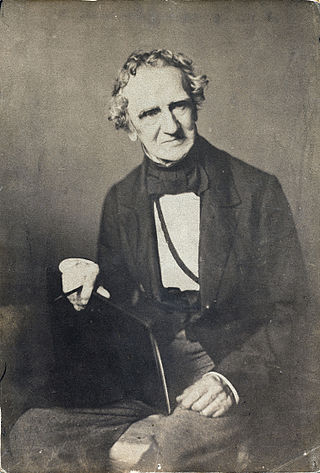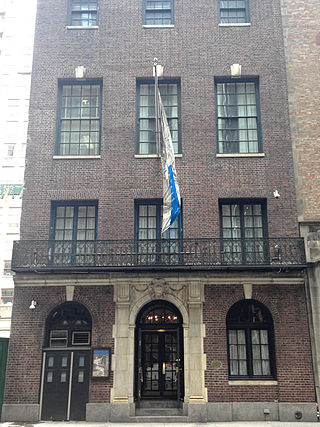
The University of Virginia (UVA) is a public research university in Charlottesville, Virginia, United States. It was founded in 1819 by Thomas Jefferson and contains his Academical Village, a UNESCO World Heritage Site. The original governing Board of Visitors included three U.S. presidents: Jefferson, James Madison, and James Monroe, the latter as sitting president of the United States at the time of its foundation. As its first two rectors, Presidents Jefferson and Madison played key roles in the university's foundation, with Jefferson designing both the original courses of study and the university's architecture. Located within its historic 1,135 acre central campus, the university is composed of eight undergraduate and three professional schools: the School of Law, the Darden School of Business, and the School of Medicine.

James Hadley Billington was an American academic and author who taught history at Harvard and Princeton before serving for 42 years as CEO of four federal cultural institutions. He served as the 13th Librarian of Congress after being nominated by President Ronald Reagan in 1987, and his appointment was approved unanimously by the U.S. Senate. He retired as Librarian on September 30, 2015.

Asher Brown Durand was an American painter of the Hudson River School.
Patrick Bruce "Pat" Oliphant is an Australian-born American artist whose career spanned more than sixty years. His body of work as a whole focuses mostly on American and global politics, culture, and corruption; he is particularly known for his caricatures of American presidents and other powerful leaders. Over the course of his long career, Oliphant produced thousands of daily editorial cartoons, dozens of bronze sculptures, as well as a large oeuvre of drawings and paintings. He retired in 2015.

Thomas Sully was an American portrait painter in the United States. Born in Great Britain, he lived most of his life in Philadelphia, Pennsylvania. He painted in the style of Thomas Lawrence. His subjects included national political leaders such as United States presidents: Thomas Jefferson, John Quincy Adams, and Andrew Jackson, Revolutionary War hero General Marquis de Lafayette, and many leading musicians and composers. In addition to portraits of wealthy patrons, he painted landscapes and historical pieces such as the 1819 The Passage of the Delaware. His work was adapted for use on United States coinage.

Mary Ellen Miller is an American art historian and academician specializing in Mesoamerica and the Maya.
Rare Book School (RBS) is an independent 501(c)(3) non-profit organization based at the University of Virginia. It supports the study of the history of books, manuscripts, and related objects. Each year, RBS offers about 30 five-day courses on these subjects. Most of the courses are offered at its headquarters in Charlottesville, Virginia but others are held in New York City, Washington, D.C., and Baltimore, Maryland. Its courses are intended for teaching academics, archivists, antiquarian booksellers, book collectors, conservators and bookbinders, rare book and special collections librarians, and others with an interest in book history.

Michael Douglas Coe was an American archaeologist, anthropologist, epigrapher, and author. He is known for his research on pre-Columbian Mesoamerica, particularly the Maya, and was among the foremost Mayanists of the late twentieth century. He specialised in comparative studies of ancient tropical forest civilizations, such as those of Central America and Southeast Asia. He held the chair of Charles J. MacCurdy Professor of Anthropology, Emeritus, Yale University, and was curator emeritus of the Anthropology collection in the Peabody Museum of Natural History, where he had been curator from 1968 to 1994.

Douglas Kent Hall was an American writer and photographer. Hall was a fine art photographer and writer of fiction, poetry, nonfiction, essays, and screenplays. His first published photographs were of Jimi Hendrix and Jim Morrison, and his first exhibition of photographs was at the Whitney Museum of American Art.

The Grolier Club is a private club and society of bibliophiles in New York City. Founded in January 1884, it is the oldest existing bibliophilic club in North America. The club is named after Jean Grolier de Servières, Viscount d'Aguisy, Treasurer General of France, whose library was famous; his motto, "Io. Grolierii et amicorum" [of or belonging to Jean Grolier and his friends], suggested his generosity in sharing books. The Club's stated objective is "the literary study of the arts pertaining to the production of books, including the occasional publication of books designed to illustrate, promote and encourage these arts; and the acquisition, furnishing and maintenance of a suitable club building for the safekeeping of its property, wherein meetings, lectures and exhibitions shall take place from time to time ..."
William Edmond Gates was an American Mayanist. Most of his research focused around Mayan language hieroglyphs. He also collected Mesoamerican manuscripts. Gates studied Mayan-based languages like Yucatec Maya, Ch'olti', Huastec and Q'eqchi'. Biographies state that he could speak at least 13 languages. Works and archives related to Gates reside in the collections of Brigham Young University.
René d'Harnoncourt was an Austrian-born American art curator. He was Director of the Museum of Modern Art, New York, from 1949 to 1967.

Charles Balthazar Julien Févret de Saint-Mémin was a French portrait painter and museum director. He left France during the Revolution, and worked as a portrait engraver in the United States in the early 19th century. He created portraits from life of George Washington, Thomas Jefferson, and others. He later served as museum director in Dijon.

Terry Belanger is the founding director of Rare Book School (RBS), an institute concerned with education for the history of books and printing, and with rare books and special collections librarianship. He is University Professor Emeritus at the University of Virginia (UVa), where RBS has its home base. Between 1972 and 1992, he devised and ran a master's program for the training of rare book librarians and antiquarian booksellers at the Columbia University School of Library Service. He is a 2005 MacArthur Fellow.
Charles Ryskamp was an American director of both The Frick Collection and the Pierpont Morgan Library, a longtime professor at Princeton University, and an avid collector of drawings and prints. He was born in East Grand Rapids, Michigan, or Grand Rapids, Michigan. At the time of his death the Yale Center for British Art had selections from his collection featured in the exhibition "Varieties of Romantic Experience: Drawings from the Collection of Charles Ryskamp". This exhibition, which was to be up from February 4 until April 25, 2010, included works from Ryskamp's collection by Romantic period artists such as J. M. W. Turner, William Blake, David Wilkie and Caspar David Friedrich. His collection of Danish Golden Age drawings with works by among others Christen Købke and Johan Thomas Lundbye was one of the finest in private hands.

The Fralin Museum of Art is an art museum at the University of Virginia. Before 2012, it was known as the University of Virginia Art Museum. It occupies the historic Thomas H. Bayly Building on Rugby Road in Charlottesville, Virginia, a short distance from the Rotunda. The museum's permanent collection consists of nearly 14,000 works; African art, American Indian art, and European and American painting, photography, and works on paper are particularly well represented. The Fralin serves as a teaching museum for academic departments in the university, and serves the community at large with several outreach programs. Admission is free of charge and open to the public.

The history of the University of Virginia opens with its conception by Thomas Jefferson at the beginning of the early 19th century. The university was chartered in 1819, and classes commenced in 1825.
George Thomas Tanselle is an American textual critic, bibliographer, and book collector, especially known for his work on Herman Melville. He was Vice President of the John Simon Guggenheim Foundation from 1978 to 2006.
Albert E. Rees was an American economist and noted author. An influential labor economist, Rees taught at Princeton University from 1966 to 1979, while also being an advisor to President Gerald Ford. He was also a former Provost of Princeton and former president of the Alfred P. Sloan Foundation. He was also the first head of the Council on Wage and Price Stability, a short-lived federal agency.
Lola L. Szladits (1923-1990) was an American librarian. She was the curator of New York Public Library's Berg Collection of English and American Literature for twenty years.












